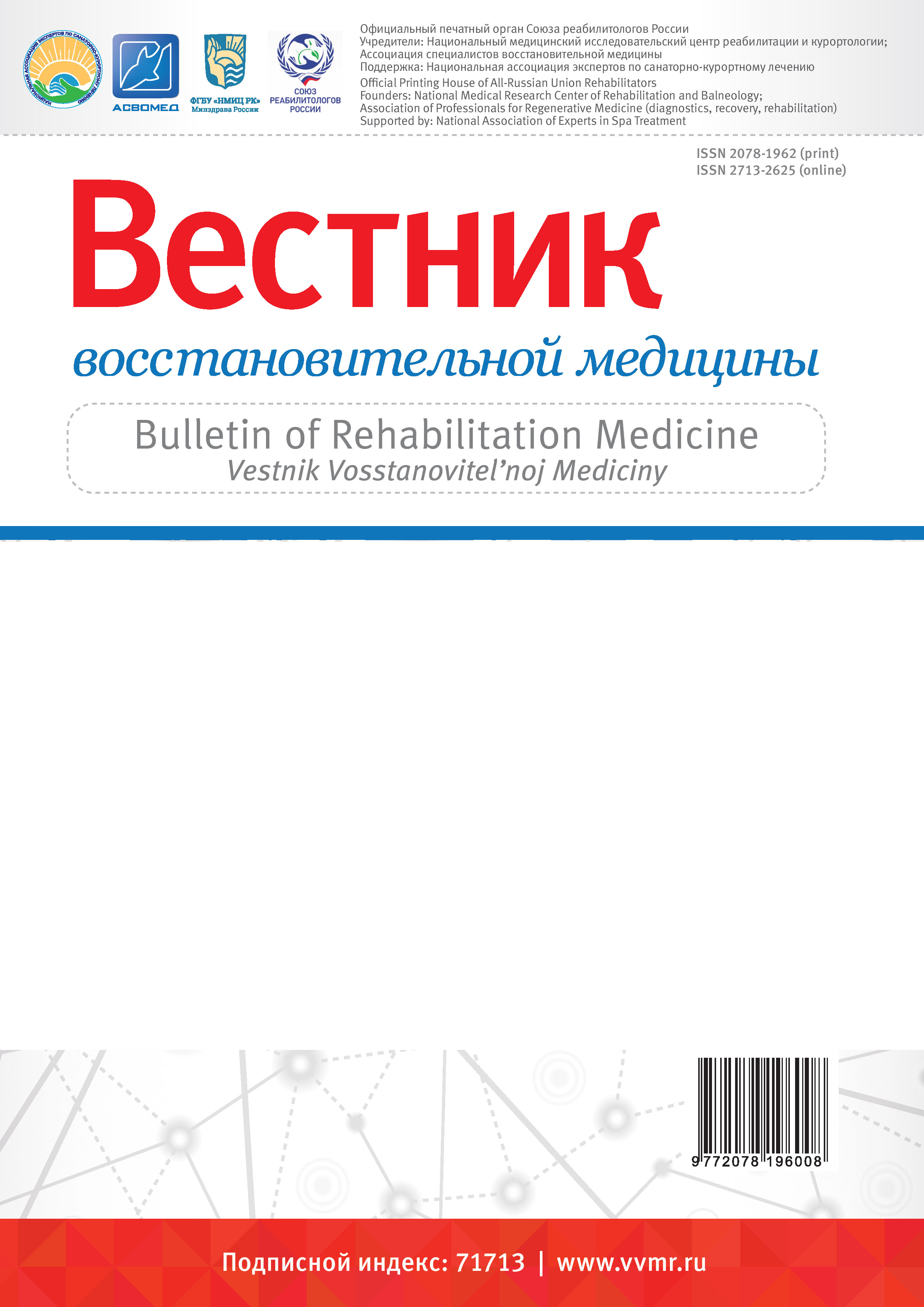Госпиталь для ветеранов войн №3, Москва, Россия
AIM. To determine the concentration of connective tissue growth factor and assess the relationship of this index with a number of pathological conditions in elderly patients with CHD. MATERIAL AND METHODS. The study enrolled 50 patients older than 75 years with a diagnosis of coronary heart disease (CAD); most of them (71%) were women. The patients ranged in age from 75 to 96 years (mean age -87.8 years). The concentration of connective tissue growth factor (CTGF) in blood was determined by enzyme immunoassay. RESULTS AND DISCUSSION. In the group of CHD patients, the average CTGF concentration was 357.2 pg/ml, whereas in healthy young adults it was 1076.7 pg/ml (p=0.07). Only 7.9% of patients with CHD had CTGF level exceeding 1000 pg/ml, whereas in young subjects CTGF level exceeded 1000 pg/ml in 25% of cases. In patients with clinically significant CHD, CTGF concentration was significantly higher than in patients without CHD (p=0.001). A negative correlation was registered between the CTGF levels and the systolic (r = -0.25; p = 0.1) and diastolic (r = -0.36; p = 0.02) blood pressure. In the subgroup of patients with pneumosclerosis, the median CTGF concentration reached 190.7 pg/l, without it – 34.7 pg/ml (p = 0.03). A significant inverse correlation was found between the CTGF levels and glucose (r = -0.34; p = 0.03), total cholesterol (r = -0.49; p = 0.002) and LDL cholesterol (r = -0.40; p = 0.01) concentrations. This pilot study found a significant effect of CTGF on echocardiographic parameters and the course of CHD, and higher levels of CTGF in patients with pneumosclerosis. However, a small sample of patients and extremely variable CTGF values do not currently allow unequivocal conclusions to be drawn at this time about the role of this factor in various comorbid conditions. CONCLUSION. Further research is needed to establish the clinical significance of CTGF.
connective tissue growth factor, fibrosis, coronary heart disease, hypertension, heart failure, atrial fibrillation, bone mineral density, asthenia
1. Arnott J.A., Lambi A.G., Mundy C. et al. The role of connective tissue growth factor (CTGF/CCN2) in skeletogenesis. Critical Reviews™ in Eukaryotic Gene Expression. 2011; 21(1): 43-69. https://doi.org/10.1615/critreveukargeneexpr.v21.i1.40
2. Ponticos M. Connective tissue growth factor (CCN2) in blood vessels. Vascular Pharmacology. 2013; 58(3): 189-93. https://doi.org/10.1016/j.vph.2013.01.004
3. Cicha I., Yilmaz A., Klein M. et al. Connective tissue growth factor is overexpressed in complicated atherosclerotic plaques and induces mononuclear cell chemotaxis in vitro. Arteriosclerosis, Thrombosis, and Vascular Biology. 2005; 25(5): 1008-13. https://doi.org/10.1161/01.ATV.0000162173.27682.7b
4. Cicha I., Yilmaz A., Suzuki Y., et al. Connective tissue growth factor is released from platelets under high shear stress and is differentially expressed in endothelium along atherosclerotic plaques. Clinical Hemorheology and Microcirculation. 2006; 35(1-2): 203-206.
5. Meng Y., Tian C., Liu L., Wang L., Chang Q. Elevated expression of connective tissue growth factor, osteopontin and increased collagen content in human ascending thoracic aortic aneurysms. Vascular. 2014; 22(1): 20-27. https://doi.org/10.1177/1708538112472282
6. Sachdeva J., Mahajan A., Cheng J. et al. Smooth muscle cell-specific haploinsufficiency restricts the progression of abdominal aortic aneurysm by modulating CTGF expression. PLoS One. 2017; 12(5): e0178538. https://doi.org/10.1371/journal.pone.0178538
7. Gerritsen K.G., Falke L.L., van Vuuren S.H. et al for the SMART Study Group. Plasma CTGF is independently related to an increased risk of cardiovascular events and mortality in patients with atherosclerotic disease: the SMART study. Growth Factors. 2016; 34(3-4): 149-58. https://doi.org/10.1080/08977194.2016.1210142
8. Hunt K.J., Jaffa M.A., Garrett S.M. et al. Plasma connective tissue growth factor (CTGF/CCN2) levels predict myocardial infarction in the veterans affairs diabetes trial (VADT) cohort. Diabetes Care. 2018; 41(4): 840-46. https://doi.org/10.2337/dc17-2083
9. Ungvari Z., Valcarcel-Ares M.N., Tarantini S. et al. Connective tissue growth factor (CTGF) in age-related vascular pathologies. GeroScience. 2017; 39(5- 6): 491-98. https://doi.org/10.1007/s11357-017-9995-5
10. Jun J.I.I., Lau L.F. CCN2 induces cellular senescence in fibroblasts. Journal of Cell Communication and Signaling. 2017; 11(1): 15-23. https://doi.org/10.1007/s12079-016-0359-1
11. Behnes M., Brueckmann M., Lang S. et al. Connective tissue growth factor (CTGF/CCN2): Diagnostic and prognostic value in acute heart failure. Clin- ical Research in Cardiology. 2014; 103(2): 107-116. https://doi.org/10.1007/s00392-013-0626-6
12. Chi H., Feng H., Shang X. et al. Circulating Connective Tissue Growth Factor Is Associated with Diastolic Dysfunction in Patients with Diastolic Heart Failure. Cardiology. 2019; 143(3-4): 77-84. https://doi.org/10.1159/000499179
13. Koitabashi N., Arai M., Niwano K. et al. Plasma connective tissue growth factor is a novel potential biomarker of cardiac dysfunction in patients with chronic heart failure. European Journal of Heart Failure. 2008; 10(4): 373-79. https://doi.org/10.1016/j.ejheart.2008.02.011
14. Ko W.C., Hong C.Y., Hou S.M. et al. Elevated expression of connective tissue growth factor in human atrial fibrillation and angiotensin II-treated car- diomyocytes. Circulation Journal. 2011; 75(7): 1592-1600. https://doi.org/10.1253/circj.cj-10-0892
15. Chen J.Q., Guo Y.S., Chen Q. et al. TGFβ1 and HGF regulate CTGF expression in human atrial fibroblasts and are involved in atrial remodelling in patients with rheumatic heart disease. Journal of Cellular and Molecular Medicine. 2019; 23(4): 3032-39. https://doi.org/10.1111/jcmm.14165
16. Wang Q., Wang X., Yin L. et al. Human Epicardial Adipose Tissue cTGF Expression is an Independent Risk Factor for Atrial Fibrillation and Highly Associated with Atrial Fibrosis. Scientific Reports. 2018; 8(1): 3585. https://doi.org/10.1038/s41598-018-21911-y
17. Leeuwis J.W., Nguyen T.O., Theunissen M.G.J. et al. Connective tissue growth factor is associated with a stable atherosclerotic plaque phenotype and is involved in plaque stabilization after stroke. Stroke. 2010; 41(12): 2979-2981. https://doi.org/10.1161/STROKEAHA.110.589036
18. Naguib M., Rashed L. Urinary connective tissue growth factor level in relation to nephropathy and retinopathy in patients with type 2 diabetes. Kasr Al Ainy Medical Journal. 2018; 24(1): 14-18. https://doi.org/10.4103/kamj.kamj_39_17
19. Lipson K.E., Wong C., Teng Y., Spong S. CTGF is a central mediator of tissue remodeling and fibrosis and its inhibition can reverse the process of fibro- sis. Fibrogenesis & Tissue Repair. 2012; 5(1): S24. https://doi.org/10.1186/1755-1536-5-S1-S24
20. Jang J.H., Chand H.S., Bruse S., et al. Connective Tissue Growth Factor Promotes Pulmonary Epithelial Cell Senescence and Is Associated with COPD Severity. COPD: Journal of Chronic Obstructive Pulmonary Disease. 2017; 14(2): 228-37. https://doi.org/10.1080/15412555.2016.1262340
21. Xu B., Wang X., Wu C. et al. Flavonoid compound icariin enhances BMP-2 induced differentiation and signalling by targeting to connective tissue growth factor (CTGF) in SAMP6 osteoblasts. PLoS One. 2018; 13(7): e0200367. https://doi.org/10.1371/journal.pone.0200367






